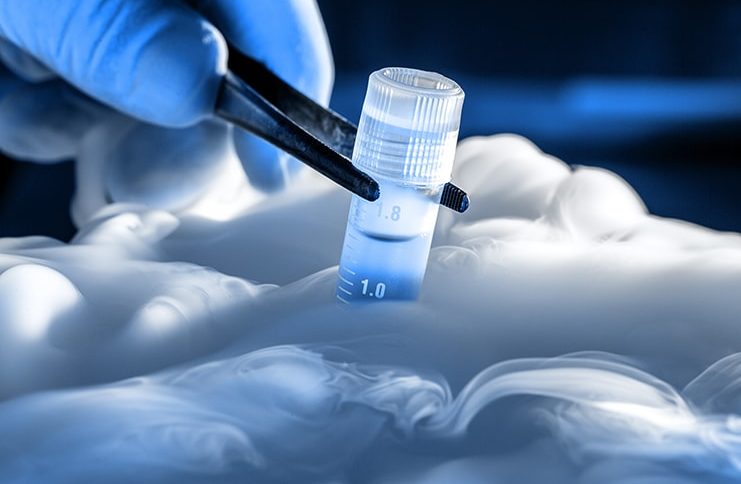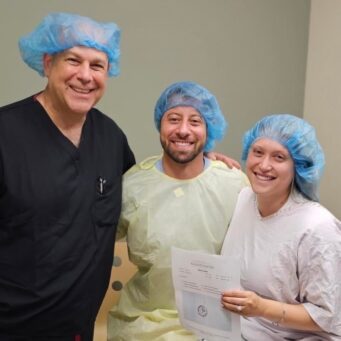
When exploring fertility treatments, you’re sure to stumble on some wacky sounding unfamiliar terms along the way. But “sperm washing”? That sounds like something that would make you want to delete your Google history. Before your mind wanders fully into the gutter, you should know that sperm washing is an integral part of a potential first stop on the journey to baby – intrauterine insemination.
The IUI Process
So what exactly is intrauterine insemination (IUI)? It is the act of collecting a partner or donor’s semen, putting it through the process of “sperm washing”— through which swimming sperm are separated from non-swimming sperm — and then placing the swimming sperm into the woman’s uterus right around the time of ovulation. This is explained by Dr. Mazen Abdallah, a reproductive endocrinology and infertility specialist with McGovern Medical School at UTHealth and Children’s Memorial Hermann Hospital. He says the procedure, which is minimally invasive, is “very tolerable; you won’t feel more discomfort than a pap smear.”
Forget what you may have seen in the movies – no turkey basters are involved.
Also, forget what you may have seen in the movies – no turkey basters are involved. Dr. Elizabeth Ginsburg, medical director of Assisted Reproductive Technologies at Brigham and Women’s Hospital says that a 1-mm-wide catheter is used to pass the sample through a woman’s cervix into the uterus. “This bypasses cervical mucus and gets more sperm into the uterus and closer to the fallopian tubes where the egg is fertilized, than during sexual intercourse,” she says.
IUI is one of the oldest types of fertility treatments—records show that some of the first attempts were done in the 1400s in Europe! However, IUI the way we currently think of it developed as a treatment around the 1960s and has been available in the United States since 1987, experts say. Hard numbers on how many patients undergo it are hard to come by, because, unlike other fertility treatments, there is no national registry to track who gets the treatment, and a variety of medical professionals perform it.
Ideal Candidates for IUI
Dr. Angela Jones, a New Jersey-based OB/GYN, says candidates for the process include couples where the man in the equation may have “’sperm issues'” such as motility problems, low sperm count, or when there is an issue with premature ejaculation or impotence.” Other patients that may be candidates are single women or same-sex partners who want to have a baby, couples who are experiencing unexplained infertility, and women who have a semen allergy or have a cervical mucus problem, she notes.
“In order to be a candidate, you must have a healthy uterus and fallopian tubes that are patent [open],” Jones says.
IUI vs. IVF
IUI may call to mind another well-known fertility treatment acronym— IVF, which stands for in vitro fertilization. Ginsburg explains: “In IVF, eggs are removed from the ovaries using an ultrasound-guided needle, fertilized in a dish, and [the] resulting embryo or embryos placed into a thin catheter then, as in IUI, into the uterus.”
Abdallah, who is also medical director of the Houston Fertility Institute, says, “As treatments, [IUI and IVF] are different. With IUI, you let the sperm find the egg on its own, while with IVF, you get the sperm and egg together.”
Typically, IUI is one of the first options when exploring fertility treatments. (That is, if the parents-to-be are candidates.) “We reserve IVF for when IUI has failed,” Abdallah says. “After six cycles of IUI, [though], if it hasn’t worked by that point, it’s [probably] not going to work.” Which would then mean it’s time to explore other options.
The Cost-Benefit Question
In addition to the actual processes, IUI and IVF also differ greatly when it comes to two other things: cost and success rates. Abdallah says that the cost of about four cycles of IUI is comparable to about one round of IVF. (Depending on whether medicine is needed to kick-start ovulation, one round of IUI can range from a few hundred dollars to about $1,500, according to Abdallah. One round of IVF has about a $10,000 price tag, he says.) When it comes to success rates, a woman 35 or younger who has undergone four cycles of IUI with injectable medicine to aid with ovulation has about a 32% chance of getting pregnant, compared to 50% with one round of IVF for a woman of the same age, Abdallah says.
Ginsburg agrees that IUI can be successful although women have better chances with IVF. She notes that there is no evidence that IUI improved pregnancy rates in couples with infertility that is unexplained – that is, where there is no immediately apparent problem.
“With IUI, pregnancy rates go up and are approximately 10% per cycle of treatment if used, for example, with an oral medication that increases the number of eggs a woman ovulates, she says. “In comparison, one cycle of IVF treatment with transfer of one embryo (fertilized egg) in a woman of 33 leads to a 45% to 50% chance of live birth.”
Another thing to note when it comes to IUI is the chance for multiples, according to Abdallah. About 5% to 10% of all pregnancies with this method will be of twins, while up to additional 5% of IUI pregnancies may be triplets or more if the treatment is not carefully monitored.
All In The Timing
Jones points out that when it comes to IUI, timing is everything. “Both partners need to be available at the time of ovulation.” Additionally, “depending on the source of the specimen, your partner may have to masturbate and ejaculate into a cup.” (Talk about taking the spontaneity out of things.) It doesn’t mean that that part of the process can’t be made a little more exciting with some magazines or well-timed iPhone photos. I mean, after all, you already have “sperm washing” in your search history. Why not add a bit more fun?
Contributor
Kelsey Butler
Kelsey Butler is a reporter and editor based in New Jersey. She has written for health and lifestyle publications including Women's Health and Brides. In her spare time, you can find her on the bocce court, collecting souvenir pennies, binging “Law & Order: SVU” episodes and hiking with her dog, Sonny.

Listen to stories, share your own, and get feedback from the community.


















